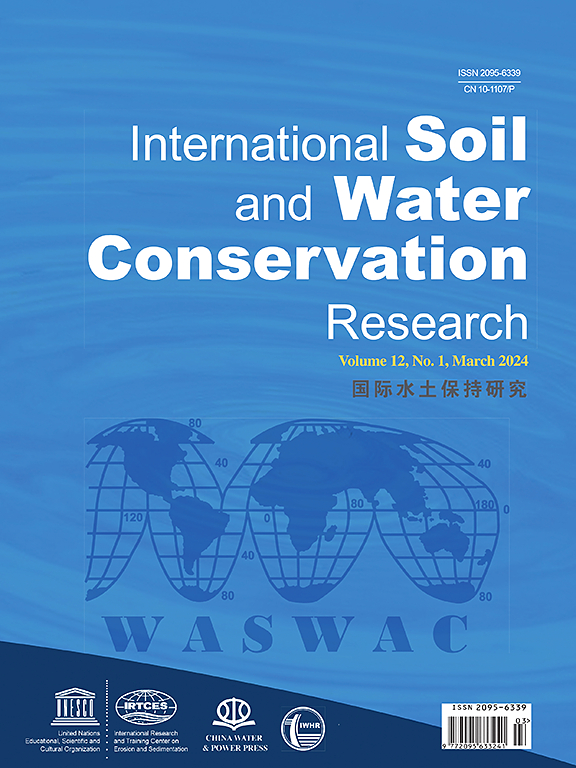被动微波遥感在土壤水分反演中的应用:产品、模型、应用与挑战
IF 7.3
1区 农林科学
Q1 ENVIRONMENTAL SCIENCES
International Soil and Water Conservation Research
Pub Date : 2025-07-03
DOI:10.1016/j.iswcr.2025.06.006
引用次数: 0
摘要
土壤水分是全球水循环的重要组成部分,是陆地碳循环的重要环境参数,对能量交换、植被动态和生态系统生产力具有重要影响。它的时空分布为气候模型和水资源管理提供了重要的见解,特别是在预测极端天气事件和优化农业实践方面。无源微波遥感以其全天候、覆盖范围广、效率高等特点,已成为地磁估计的主要方法。近几十年来,由于技术创新和卫星数据可用性的增加,微波SM检索取得了重大进展,导致无源微波SM产品的发展和广泛采用。尽管微波SM检索技术取得了重大进展,但对无源微波SM的研究进展、检索方法、应用热点、不足和未来展望等方面的文献综述仍然缺乏。为了弥补这一空白,本研究对无源微波SM研究进行了系统深入的探索。首先,介绍了无源微波SM检索的基本原理,为理解其基本机制奠定了基础。随后,回顾了主要的检索方法,包括基于物理的辐射传输模型和机器学习算法,重点讨论了它们各自的优势和局限性。此外,该研究还介绍了目前主流的无源微波SM产品,详细介绍了它们的具体属性,如空间分辨率、时间频率和可用时间。在此基础上,通过基于VOS(相似度可视化)查看器的关键词共现技术,对现有无源微波SM产品的具体应用进行了全面分类。结果表明,这些产品主要用于环境科学和生态学的数据同化、干旱监测、降雨估计和洪水预报等应用。此外,被动微波SM数据越来越多地应用于与人类活动相关的领域,如灾害预警、军事模拟和车辆速度建模,强调了它们的多功能性,并在自然和人为背景下扩大了相关性。尽管在这些领域取得了显著进展,但外部环境因素导致的数据缺口、空间分辨率降低和精度下降等持续挑战继续限制无源微波SM产品在各种应用场景中的全部潜力。最后,本研究对无源微波SM研究进行了前瞻性展望,旨在解决当前面临的挑战,推动微波SM产品的发展。总之,本研究旨在促进被动微波SM检索和应用的不断发展,从而加强水土保持工作的科学基础和实践效果。本文章由计算机程序翻译,如有差异,请以英文原文为准。
The passive microwave remote sensing in soil moisture retrieval: Products, models, applications and challenges
Soil moisture (SM) is a pivotal component of the global water cycle and a critical environmental parameter in terrestrial carbon cycling, significantly influencing energy exchange, vegetation dynamics, and ecosystem productivity. Its spatial and temporal distribution offers critical insights for climate models and water resource management, particularly in predicting extreme weather events and optimizing agricultural practices. Passive microwave remote sensing, characterized by its all-weather capability, extensive coverage, and high efficiency, has emerged as the primary method for SM estimation. Over recent decades, significant progress in microwave SM retrieval has been driven by technological innovations and increased satellite data availability, resulting in the development and widespread adoption of passive microwave SM products. Notwithstanding the significant progress in microwave SM retrieval techniques, a comprehensive literature review on passive microwave SM, encompassing research advancements, retrieval methods, application hotspots, shortcomings, and future prospects, remains notably absent. To address this gap, this study undertakes a systematic and in-depth exploration of passive microwave SM research. Initially, the fundamental principles of passive microwave SM retrieval are introduced, establishing the groundwork for understanding the underlying mechanisms. Subsequently, the primary retrieval methods are reviewed, including physically-based radiative transfer models and machine learning algorithms, with a focus on their respective strengths and limitations. Additionally, the study introduces the current mainstream passive microwave SM products, detailing their specific attributes such as spatial resolution, temporal frequency, and available time. Following this, a thorough classification of the specific applications of existing passive microwave SM products is conducted through the VOS (Visualization of Similarities) viewer-based keyword co-occurrence technique. The findings indicate that these products are predominantly utilized in environmental science and ecology for applications such as data assimilation, drought monitoring, rainfall estimation, and flood forecasting. Moreover, passive microwave SM data are increasingly being applied in fields related to human activities, such as disaster early warning, military simulation, and vehicle speed modeling, underscoring their versatility and expanding relevance in both natural and anthropogenic contexts. Despite the notable progress in these areas, persistent challenges such as data gaps, lower spatial resolution, and degraded accuracy caused by external environmental factors continue to limit the full potential of passive microwave SM products across diverse application scenarios. In the end, this study offers a forward-looking perspective on passive microwave SM research, with the goal of addressing current challenges and advancing the development of microwave SM products. In conclusion, the study seeks to contribute to the continued evolution of passive microwave SM retrieval and application, thereby strengthening the scientific foundation and practical effectiveness of soil and water conservation efforts.
求助全文
通过发布文献求助,成功后即可免费获取论文全文。
去求助
来源期刊

International Soil and Water Conservation Research
Agricultural and Biological Sciences-Agronomy and Crop Science
CiteScore
12.00
自引率
3.10%
发文量
171
审稿时长
49 days
期刊介绍:
The International Soil and Water Conservation Research (ISWCR), the official journal of World Association of Soil and Water Conservation (WASWAC) http://www.waswac.org, is a multidisciplinary journal of soil and water conservation research, practice, policy, and perspectives. It aims to disseminate new knowledge and promote the practice of soil and water conservation.
The scope of International Soil and Water Conservation Research includes research, strategies, and technologies for prediction, prevention, and protection of soil and water resources. It deals with identification, characterization, and modeling; dynamic monitoring and evaluation; assessment and management of conservation practice and creation and implementation of quality standards.
Examples of appropriate topical areas include (but are not limited to):
• Conservation models, tools, and technologies
• Conservation agricultural
• Soil health resources, indicators, assessment, and management
• Land degradation
• Sustainable development
• Soil erosion and its control
• Soil erosion processes
• Water resources assessment and management
• Watershed management
• Soil erosion models
• Literature review on topics related soil and water conservation research
 求助内容:
求助内容: 应助结果提醒方式:
应助结果提醒方式:


